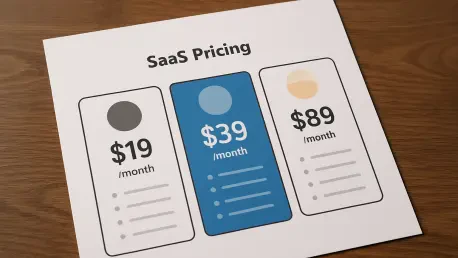Artificial intelligence has remixed the economics of software. A decade ago, most business-to-business SaaS companies had a straightforward answer to the pricing question: count the seats and multiply by a monthly subscription fee. That model thrived when more users meant more value, and the marginal cost of delivering software was close to zero. In 2025, however, the marginal cost of AI inference is very real, and the customers you serve may reduce their seat count as your product gets better. Pricing has become a board‑level concern; the cost of providing graphics processing unit minutes, API calls, or AI‑generated outputs can overwhelm traditional revenue models.
This piece synthesizes the latest pricing benchmarks and field reports to help SaaS leaders determine when to use traditional seat-based pricing, usage-based pricing, or AI credit systems.
What the 2025 Data Says
The 2025 pricing landscape looks very different from the subscription‑only world of the early 2010s. Surveys indicate that hybrid models combining subscription and usage charges drive the highest median growth (21%), outperforming both pure subscription and pure usage models. The same report notes that 44% of SaaS companies now charge separately for AI‑powered features, and that multi‑year contracts account for 40% of agreements, up from 14% in 2022. Usage‑based billing isn’t just a fad: 85% of surveyed software companies have already adopted some form of usage‑based pricing, and 77% of the largest software companies incorporate consumption‑based elements. Even early‑stage startups are embracing this route, with 64% of Forbes’ “Next Billion‑Dollar Startups” leveraging it.
At the same time, value‑based pricing is ascendant. In a 2025 benchmark study covering more than 100 companies, 78% primarily implement value‑based pricing – an increase from 62% in 2023. Usage‑based models have increased by 31% since 2023, and 56% of companies now incorporate some consumption‑based element. Within data‑intensive sectors such as analytics and AI infrastructure, that figure jumps to 74%. The adoption surge reflects both customer demand for flexibility and the operational reality that AI workloads have non‑trivial marginal costs; credits and usage meters help align revenue with those costs.
Seat-based pricing remains prominent, but its dominance is waning. Growth Unhinged’s 2025 State of B2B Monetization report notes that seat‑based pricing fell from 21% to 15% of companies in just 12 months, while hybrid pricing rose from 27% to 41%. SaaStr’s macro analysis shows that SaaS prices are growing faster than market inflation; pricing hikes accounted for up to 72% of Salesforce’s revenue growth between 2022 and 2025, and U.S. businesses now spend about $7,900 per employee annually on SaaS tools, up 27% in two years. Customers are paying more per seat, but they also expect AI features and fairness. Only 23% of enterprises say they can accurately predict their AI spend, and unpredictability is a major adoption barrier.
These benchmarks underline a key truth: pricing is now a system design problem. Seats, usage meters, and credits are different levers in that system. Choosing the right lever depends on how your product delivers value, how costs accrue, and how your buyers prefer to budget.
When Seat‑Based Pricing Still Works
Seat‑based pricing remains effective under specific conditions: when the value of your product scales linearly with the number of users and when customers perceive fairness in paying per person. Team collaboration tools (like Slack, Notion) and CRM systems (like Salesforce Sales Cloud) exemplify this model. SaaStr’s analysis notes that Salesforce’s top tiers now cost around $500 per seat per month, roughly double the price five years ago; despite complaints, the company continues to raise prices because revenue correlates with seat count and large enterprises can justify the spend. However, seat overages are no longer merely foregone revenue; AI overages represent real costs, and CFOs increasingly resist bundling AI into seats.
Use seats when:
Workflow value grows with the team. In sales tools, marketing automation, or collaboration platforms, more users often mean more deals closed or campaigns run. Seats provide predictable revenue, straightforward budgeting, and align with how leaders think about headcount.
The product’s marginal cost is low. Traditional SaaS enjoys high gross margins (80–90%), whereas AI‑native companies average 50–60% gross margins. If your product doesn’t rely on expensive inference, seat pricing can be profitable and simple.
User identities drive governance or compliance. Seat‑based billing enforces accountability and access controls, which matters for regulated industries.
Avoid seats when: your AI product reduces the need for seats. If your generative writing tool allows a team of five to produce the output of a team of fifty, charging per user disincentivizes adoption. Intercom demonstrated this point when it shifted its support bot pricing from $39 per agent to $0.99 per AI‑resolved conversation, boosting adoption and cutting customers’ support costs. As AI automates tasks, seat‑based models can shrink your total addressable market.
When Usage‑Based Pricing Takes Over
Usage‑based pricing charges customers based on consumption – API calls, tokens, compute hours, or documents processed. This model aligns revenue with variable costs and gives customers a low barrier to entry. OpenView Partners’ 2024 study found that more than 61% of new B2B SaaS products are exploring usage‑based models, while Metronome’s 2025 report shows that 85% of surveyed companies have adopted this tool. Hybrid pricing, which pairs a base subscription with usage overages, is now the fastest‑growing structure.
Use usage‑based pricing when:
Your product’s cost scales with usage. AI inference consumes GPU time and API calls. Without usage charges, heavy users destroy margins.
Customers want to start small. This model lowers the entry barrier; a lightweight chatbot might cost $20 per month, while a large enterprise pays $2,000 per month. This dynamic helps startups win deals against incumbents.
Workloads fluctuate or are unpredictable. Developer tools (APIs, cloud databases, and machine learning platforms) have spiky usage patterns. Usage-based pricing allows upsell without renegotiation and captures value as customers grow.
Your buyers are technical and cost‑sensitive. Engineers appreciate paying for what they use. They also expect transparency and cost alerts – features that FinOps tooling must provide.
Pitfalls of Usage‑Based Pricing: revenue volatility and buyer anxiety. According to Metronome’s field report, customer anxiety over unpredictable costs is the number‑one adoption barrier. Admins don’t know how fast credits burn; CFOs can’t forecast spend. Enterprises often negotiate committed‑use deals to gain predictability. Without caps or rollovers, usage spikes can lead to sticker shock and churn. Companies adopting this model must invest in real‑time usage dashboards, alerts, and guardrails, and may need to combine a minimum base fee with consumption tiers.
When AI Credits Make Sense
AI credit systems allocate a bundle of tokens or credits that customers burn down as they consume AI services. Credits are a transitional architecture: they normalize volatile costs and allow vendors to ship AI features without re‑architecting their billing systems.
Use AI credits when:
You need speed to market. Credits let you launch AI features quickly while you figure out the long‑term value metric. Product teams favor them because existing billing systems can meter credits more easily than fine‑grained outcomes.
Your cost drivers are highly volatile. If your product relies on third-party models (OpenAI, Anthropic, Cohere) with unpredictable usage charges, bundling credits helps you stabilize your revenue and avoid incurring huge overages.
Your buyers are experimenting. Credits provide flexibility for customers to test different features without committing to a specific usage pattern.
Challenges with AI credits: buyers often lack an understanding of what a credit represents. Metronome’s interviewees admitted that customers “don’t know what a credit does” and that credits are not intuitive value stories. For enterprise deals, credits can trigger procurement delays because CFOs struggle to evaluate ROI. The most successful companies treat credits as a stepping stone toward a more transparent value metric. They offer generous free trials, annual credit caps, or rollovers to reduce anxiety.
How to Decide: A Practical Framework
Choosing between seats, usage, and credits isn’t a one‑time decision. Think of pricing as an evolving portfolio. Start with a simple model that matches your initial use case, then layer on sophistication as you understand costs and customer behavior. Here’s a five‑step framework inspired by pilot, Metronome, and Monetizely research:
Define your product type and buyer. Are you an API called 10,000 times a minute or a workflow app for a team of five? The answer determines cost variability, buyer persona, and billing expectations. Developer tools tend to lean toward usage-based pricing, while workflow apps often start with subscription tiers. If your AI eliminates the very users you would charge for, start with usage or outcomes.
Identify the true value metric. Price should reflect customer outcomes, not vanity metrics. Ask the litmus question: if your product succeeds spectacularly, will customers need fewer of the thing you charge for? If yes, you need a different metric.
Understand unit costs before you ship. Hidden costs lurk in AI operations. Determine your gross margins early and align pricing accordingly. AI companies that clung to per‑seat pricing saw 40% lower gross margins and 2.3 times higher churn than those adopting usage or outcome models.
Model predictability and risk sharing. Customers fear unpredictable bills more than high rates. Offer base fees, annual credit caps, or enterprise commitments to provide budget certainty. Use consumption data to forecast revenue.
Iterate with experiments. Pricing is not static. Companies with the highest Monetization Efficiency Ratio typically use simplified tiers (three to four levels) and self-service purchase options.
What’s Next: Beyond Seats, Usage, and Credits
The next frontier is true outcome‑based pricing – charging directly for business results like leads generated, fraud prevented, or revenue influenced. Monetizely’s study shows that although only 9% of companies have fully implemented outcome‑based models, 47% are actively exploring or piloting them. AI‑native startups like Decagon price agents per conversation or per resolution, making value tangible. Yet attributing outcomes is messy; you must separate the impact of your product from changes in customer processes. Outcome models also introduce cash‑collection lags. For now, hybrid models with outcome‑based bonuses offer a pragmatic compromise.
The pricing conversation is also shifting to risk sharing. Vendors and customers will increasingly negotiate models where both parties shoulder uncertainty. Committed‑use deals, caps with rollovers, and performance‑based rebates align incentives and reduce anxiety. The rise of multi‑layered architectures means that non‑AI‑native apps may add separate AI layers or bundles. Expect to see good, better, and best subscriptions augmented with AI add-ons and credit systems that transition to consumption or outcome metrics over time.
Building a Pricing Portfolio
Your pricing model is a reflection of your product’s value and your relationship with customers. Successful SaaS companies treat pricing like a portfolio, not a pool. They use seats where collaboration drives value, usage meters where costs scale with consumption, and credits as a bridge to more sophisticated models. Successful SaaS companies also instrument unit economics to track cost per lead scored or per document summarized and re‑allocate budgets accordingly. They design for transparency and predictability because buyer confidence unlocks adoption. And they continuously iterate, shifting from seats to usage to outcomes as their products evolve.
Before approving your next pricing change, run a bottleneck audit of your pricing and billing system. Measure how long it takes to ship a new pricing experiment, how well you can forecast AI costs, and how easily customers understand their bills. Declare your “golden unit” – the one cost and quality metric that defines success. Use the data from these benchmarks as your compass. Pricing is no longer just an exercise in spreadsheets, but an essential lever of product strategy. Choose your levers wisely.









